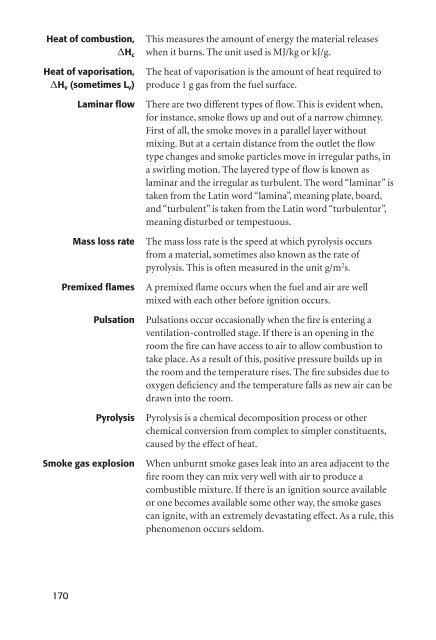You also want an ePaper? Increase the reach of your titles
YUMPU automatically turns print PDFs into web optimized ePapers that Google loves.
Heat of combustion, This measures the amount of energy the material releases<br />
DH c when it burns. The unit used is MJ/kg or kJ/g.<br />
Heat of vaporisation, The heat of vaporisation is the amount of heat required to<br />
DH v (sometimes L v) produce 1 g gas from the fuel surface.<br />
170<br />
Laminar fl ow There are two different types of fl ow. This is evident when,<br />
for instance, smoke fl ows up and out of a narrow chimney.<br />
First of all, the smoke moves in a parallel layer without<br />
mixing. But at a certain distance from the outlet the fl ow<br />
type changes and smoke particles move in irregular paths, in<br />
a swirling motion. The layered type of fl ow is known as<br />
laminar and the irregular as turbulent. The word “laminar” is<br />
taken from the Latin word “lamina”, meaning plate, board,<br />
and “turbulent” is taken from the Latin word “turbulentur”,<br />
meaning disturbed or tempestuous.<br />
Mass loss rate The mass loss rate is the speed at which pyrolysis occurs<br />
from a material, sometimes also known as the rate of<br />
pyrolysis. This is often measured in the unit g/m 2 s.<br />
Premixed fl ames A premixed fl ame occurs when the fuel and air are well<br />
mixed with each other before ignition occurs.<br />
Pulsation Pulsations occur occasionally when the fi re is entering a<br />
ventilation-controlled stage. If there is an opening in the<br />
room the fi re can have access to air to allow combustion to<br />
take place. As a result of this, positive pressure builds up in<br />
the room and the temperature rises. The fi re subsides due to<br />
oxygen defi ciency and the temperature falls as new air can be<br />
drawn into the room.<br />
Pyrolysis Pyrolysis is a chemical decomposition process or other<br />
chemical conversion from complex to simpler constituents,<br />
caused by the effect of heat.<br />
Smoke gas explosion When unburnt smoke gases leak into an area adjacent to the<br />
fi re room they can mix very well with air to produce a<br />
combustible mixture. If there is an ignition source available<br />
or one becomes available some other way, the smoke gases<br />
can ignite, with an extremely devastating effect. As a rule, this<br />
phenomenon occurs seldom.

















